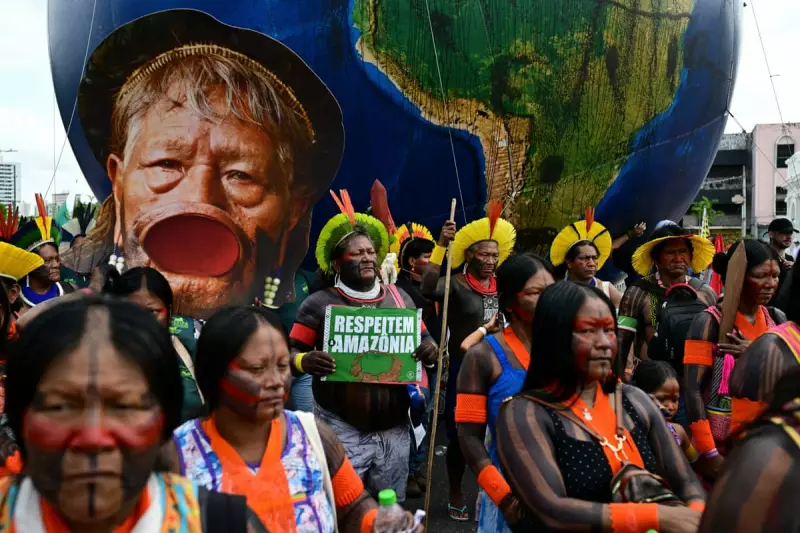
Stepping into the official negotiating area of COP30 in Belém, a Xipaya journalist describes the sensation of being swallowed whole. The experience is one of submersion, of struggling for breath within the architecture of what feels like a great creature's stomach.
The Belly of the Beast: A Clash of Rhythms
The blue zone, the heart of the UN climate conference, presents a scene of frantic, artificial life. Vast murals of a jaguar, a monkey, an anteater, and a lizard adorn the walls, while ornamental açaí palm trees and small shrubs create a makeshift, decorative forest. This is nature rendered as set dressing.
People are perpetually running, never merely walking, driven by an unrelenting haste. For a moment, this accelerated rhythm courses through the journalist's own body, compelling faster steps, quicker thoughts, and rapid breaths. The haste feels contagious, a virus of urgency from non-Indigenous society. Yet, a conscious resistance emerges. The journalist's investigations, writing, and listening are not fast-paced. The monster of haste has not entirely consumed them, but the fear of its grip remains potent.
This temporal dissonance was forged on the journey to Belém. A multi-day voyage by bus and boat from Altamira, travelling with scientists and leaders of Indigenous and riverside communities along the Tapajós River and into the vast Amazon, existed in a different dimension. Disembarking felt like leaving a world where time opens up and expands for one where time narrows and constricts.
A Temporal Crisis at the Heart of Climate Talks
At COP30, everything is framed as urgent. Voices speak of futures, goals, and funding, their cadence dictated by the clock ticking within their souls. This stands in stark contrast to the rhythm of the forest, where nothing is rushed. Trees bear fruit in their season, crops are planted at the right moment, and seeds sprout when the earth is ready.
The journalist identifies the core crisis facing COP30 as being as much temporal as it is climatic. Within these corridors, time does not flourish; it is consumed. People run so relentlessly that they fail to perceive what is lost between one step and the next. The fundamental question arises: how can the planet be saved without first relearning the rhythm of the Earth itself, without heeding the pace of the rains, the seeds, and the rivers? The rush within the blue zone may, paradoxically, be slowing the global effort to halt climate collapse.
Encounters with Resistance and Hypocrisy
Amidst the chaos, there are encounters with resistance. In the corridors, the journalist meets relatives—a term Indigenous people use for one another—from across Brazil. Their presence in debates and roundtables is intense, yet their influence in the actual negotiation rooms remains limited.
José Gregorio Díaz Mirabal, representing various Indigenous groups, voiced a critical concern: "We continue to be observers. Very few of us are in the negotiations." His determination, however, is clear: "We want the Amazon to be defended, to be respected, and for fossil fuels and monocultures to be removed, so that we can maintain the Amazon alive for Indigenous peoples and for the world."
Raquel Tupinambá, from the Tupinambá people of the Tapajós region, shared a perception of the blue zone as a vast marketplace of globalised madness, where staying focused on the core mission is a constant struggle. Her words were literally cut off, interrupted and pushed aside by the rush of a group of people, predominantly white men, who appeared to hold some authority.
Outside the official zone, a different energy thrives. The COP village hosts more than 3,000 Indigenous people from across the country, the largest such gathering at a COP. This is the collective body of the forest in motion. Here, time flows to the rhythm of conversation, sharing, and listening. The force vibrating outside seems greater than the sound of the official panels and negotiations.
Yet, glaring contradictions undermine the proceedings. While Brazil's new Tropical Forest Forever fund allocates 20% of its revenue to Indigenous and traditional communities—a positive but insufficient step—President Lula has simultaneously authorised Petrobras to drill for oil at the mouth of the Amazon River, an extremely sensitive and biodiverse region. COP30 is taking place in a threatened Amazon, and pretending to care in one direction while enabling destruction in another is the height of hypocrisy, as emphasised by Anália Tuxá, a 62-year-old chief of the Tuxá people.
The Language of Invasion
A profound linguistic and conceptual battle erupted during the conference. When Indigenous peoples from the Lower Tapajós—a region scarred by illegal mining and mercury contamination—entered the blue zone in a demonstration, several media outlets described the action as an "invasion."
This framing is a violent mischaracterisation. For these communities, an invasion is a mining barge drilling into their riverbed, contaminating their water. An invasion is mercury poisoning the fish and, consequently, their own bodies. The presence of mercury is a tangible, physical invasion they live with daily. The entry into the blue zone was not an invasion; it was a desperate cry for help from those who are being invaded every single day. It was the territory itself, through its people, insisting on being heard.
Despite the overwhelming rush and the systemic barriers, something is shifting in Belém. The paths are being opened. The time of the forest has arrived at COP.





